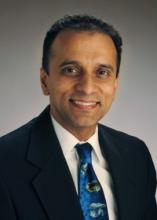Proton pump inhibitors resolve symptoms of gastroesophageal reflux disease and promote healing of erosive esophagitis regardless of a patient’s body mass index, according to a new study.
However, research findings "suggest that obese or overweight patients may be at a greater risk of advanced grades of erosive esophagitis than patients with normal weight," reported Dr. Prateek Sharma of the University of Kansas, Kansas City, Mo., and his associates (J. Clin. Gastroenterol. 2013 Feb. 24 [doi: 10.1097/MCG.0b013e31827e46be]).
Other factors such as PPI treatment and older age may also influence the odds of symptom resolution in nonerosive reflux disease (NERD) and erosive esophagitis patients.
Investigators conducted two post hoc retrospective analyses of pooled data from randomized, double-blind, multicenter studies of patients with GERD treated with PPIs.
The first analysis consisted of two studies assessing 704 subjects with NERD who received esomeprazole 20 mg (n = 228), esomeprazole 40 mg (n = 238) or placebo (n = 238).
The second analysis pooled data from five studies of 11,027 patients with erosive esophagitis treated with esomeprazole 40 mg (n = 5,519), omeprazole 20 mg (n = 2,407), or lansoprazole 30 mg (n = 3,101).
Patients were analyzed in three groups: normal weight, overweight, and obese, defined as BMI <25 kg/m2, 25 to <35 kg/m2, and greater than or equal to 35 kg/m2, respectively.
Analysis 1 demonstrated that BMI had no effect on baseline heartburn in patients with NERD (P = .28). Specifically, 21.4% of overweight and obese individuals had no heartburn symptoms at baseline, while 35.9%, 32.5%, and 10.2% had mild, moderate, and severe symptoms, respectively. In comparison, 14.3% of patients at a normal weight had no heartburn, while 38.4%, 37.9%, and 9.4%, had mild, moderate, and severe symptoms, respectively.
In Analysis 2, however, 34.7% of patients who were overweight and 32% who were obese had Los Angeles (LA) grade C or D erosive esophagitis compared with 25.5% of normal weight subjects (P < .0001). At baseline, 34.2% of overweight or obese patients had LA grade C or D of the condition.
Heartburn resolution was similar in all NERD BMI subgroups. Symptoms were successfully treated in 36.5%, 36.7%, and 32.3% of normal weight, overweight, and obese individuals taking PPIs, respectively. Healing rates with PPIs were also similar across weight categories and within erosive esophagitis LA grade.
Further analysis with logistic regression models indicated that BMI did not influence resolution of heartburn (odds ratio [OR] =1.00; 95% CI, 0.97-1.03, P = .99) or healing of erosive esophagitis healing (OR = 1.01; 95% CI, 1.00-1.02; P = .23).
However, the odds of heartburn resolution increased with esomeprazole 20 mg vs. placebo (OR = 4.26, 2.63-6.88, P < .0001), esomeprazole 40 mg vs. placebo (OR = 4.0, 2.48-6.44, P < .0001), older age (OR=1.0, 1.0-1.0, P = .0041), and in men vs. women (OR = 1.50, 1.04-2.14, P = .0284).
Additionally, the chance of erosive esophagitis healing increased with esomeprazole 40 mg vs. omeprazole 20 mg (OR = 1.70, 1.44-2.01, P < .0001), lansoprazole 30 mg vs. omeprazole 20 mg (OR = 1.30, 1.05-1.62, P = .0183), older age (OR = 1.02, 1.01-1.02, P < .0001), in black vs. white patients (OR = 0.67, 0.54-0.84, P = .0003), and hiatal hernia (OR = 1.21, 1.08-1.35, P = .0011).
The odds of erosive esophagitis healing were greater in patients with LA grade A vs. D (OR = 4.54, 3.71-5.55, P < .0001) than in patients with LA grade B vs. D (OR = 2.76, 2.30-3.32, P < .0001) or C vs. D (OR = 1.70, 1.42-2.03, P < .0001).
While this pooled analysis is limited because "data were obtained from post hoc analyses of clinical efficacy studies not designed to evaluate the effects of obesity on GERD symptom severity or treatment success," the research has "considerable statistical power" due to the large number of patients included, the investigators wrote.
The study was supported by AstraZeneca LP, in Wilmington, Del. Dr. Sharma receives research funding from Barrx Medical, Mauna Kea Technologies, Olympus, and Takeda. His coauthors disclosed ties to various pharmaceutical companies, including AstraZeneca.


